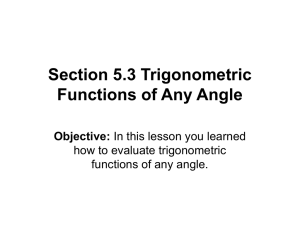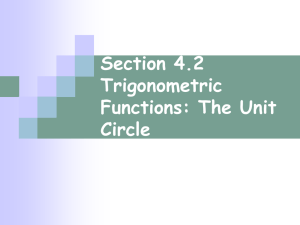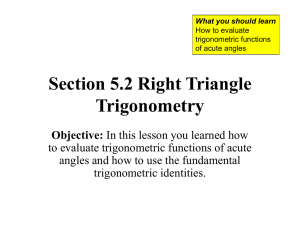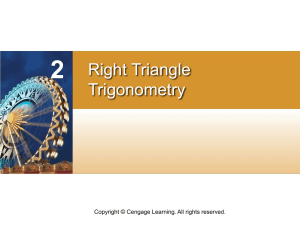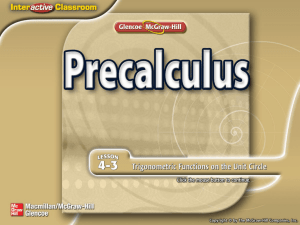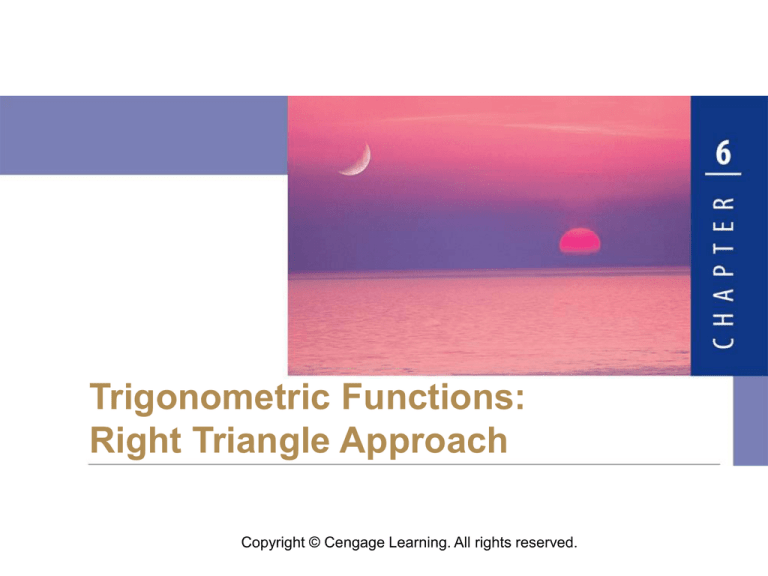
Trigonometric Functions:
Right Triangle Approach
Copyright © Cengage Learning. All rights reserved.
Trigonometric Functions
6.3
of Angles
Copyright © Cengage Learning. All rights reserved.
Objectives
► Trigonometric Functions of Angles
► Evaluating Trigonometric Functions at Any
Angle
► Trigonometric Identities
► Areas of Triangles
3
Trigonometric Functions
of Angles
4
Trigonometric Functions of Angles
Let POQ be a right triangle with acute angle as shown.
Place in standard position.
(a)
(b)
5
Trigonometric Functions of Angles
Then P = P (x, y) is a point on the terminal side of . In
triangle POQ, the opposite side has length y and the
adjacent side has length x.
Using the Pythagorean Theorem, we see that the
hypotenuse has length r =
So
The other trigonometric ratios can be found in the same
way. These observations allow us to extend the
trigonometric ratios to any angle.
6
Trigonometric Functions of Angles
We define the trigonometric functions of angles as follows.
7
Trigonometric Functions of Angles
The angles for which the trigonometric functions may be
undefined are the angles for which either the x- or
y-coordinate of a point on the terminal side of the angle
is 0.
These are quadrantal angles—angles that are coterminal
with the coordinate axes.
8
Trigonometric Functions of Angles
It is a crucial fact that the values of the trigonometric
functions do not depend on the choice of the point P(x, y).
This is because if P(x , y ) is any other point on the
terminal side, as in Figure 3, then triangles POQ and
POQ are similar.
Figure 3
9
Evaluating Trigonometric Functions
at Any Angles
10
Evaluating Trigonometric Functions at Any Angle
From the definition we see that the values of the
trigonometric functions are all positive if the angle has its
terminal side in Quadrant I.
This is because x and y are positive in this quadrant. [Of
course, r is always positive, since it is simply the distance
from the origin to the point P (x, y).] If the terminal side of
is in Quadrant II, however, then x is negative and y is
positive.
Thus, in Quadrant II the functions sin and csc are
positive, and all the other trigonometric functions have
negative values.
11
Example – Finding Trigonometric Functions of Angles
Find (a) cos 135
(b) tan 390.
12
Evaluating Trigonometric Functions at Any Angle
13
Evaluating Trigonometric Functions at Any Angle
The figure shows that to find a reference angle it’s useful
to know the quadrant in which the terminal side of the angle
lies.
The reference angle
for an angle
14
Example – Finding Reference Angles
Find the reference angle for
(a)
(b) = 870°
15
Evaluating Trigonometric Functions at Any Angle
16
Example – Using the Reference Angle to Evaluate Trigonometric Functions
Find
(a)
and
(b)
17
Trigonometric Identities
18
Trigonometric Identities
The trigonometric functions of angles are related to each
other through several important equations called
trigonometric identities.
We’ve already encountered the reciprocal identities.
These identities continue to hold for any angle , provided
that both sides of the equation are defined.
19
Trigonometric Identities
The Pythagorean identities are a consequence of the
Pythagorean Theorem.
20
Example – Expressing One Trigonometric Function in Terms of Another
(a) Express sin in terms of cos .
(b) Express tan in terms of sin , where is in Quadrant II.
21
Areas of Triangles
22
Areas of Triangles
The area of a triangle is
base height .
If is an acute angle, then the height of the triangle in
Figure 16(a) is given by h = b sin . Thus the area is
base height
And we know sin
h
and, h a sin
a
Thus,
=
sin
(a)
23
Areas of Triangles
If the angle is not acute, then we see that the height of
the triangle is
h = b sin(180° – ) = b sin
24
Example – Finding the Area of a Triangle
Find the area of triangle ABC shown.
25


